Kangaroos … in Berkeley? That’s right, mate.
You won’t find them leaping around the campus, though. Because they’re in the Museum of Paleontology’s fossil collections. In the 1950s, then-curator and professor Ruben A. Stirton decided to go to Australia’s Tirari Desert to look for fossil marsupials. He wanted to find evidence to answer the question of the origin and spread of marsupials through space and time. Did they come from Australia, Antarctica, or South America?
In the course of his research Stirton brought back over a thousand fossil marsupials, including some of the most complete skeletons known anywhere. We now know that marsupials originated in the northern continents (North America and Asia), and spread from there to Europe and South America, and then across Antarctica to Australia and New Guinea, sometime in the Late Cretaceous and Early Tertiary periods. At the end of the Cretaceous, the marsupials died out in North America. (The opossum returned to its native home when North and South America linked up again 3-4 million years ago with the formation of the Panamanian land bridge.)
Stirton’s fossils come from an interval too late in time to help with the question of marsupial origins and spread. But their diversity and preservation make them valuable to researchers to answer other questions. And this is what brought Isaac Kerr, Jacob van Zoelen, and Grant Gully to the UCMP in early June 2019. The three are PhD students at Flinders University in Adelaide, South Australia, and their trips were partly funded by the UCMP’s Samuel P. and Doris O. Welles Fund. Their PhD supervisor is Dr. Gavin Prideaux, who when a grad student many years ago was one of the first to benefit from the Welles Fund to visit UCMP.
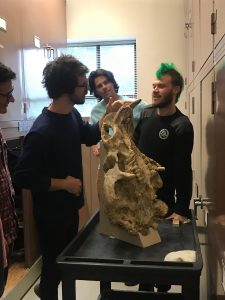
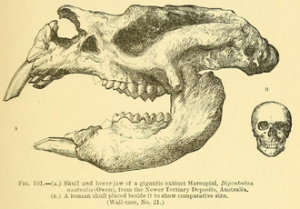
When you think of marsupials, you immediately think of kangaroos, and UCMP has a lot of them. ‘Roos are the Australian equivalent of African antelope in their diversity and ecological range, and they can vary tremendously. Isaac Kerr is studying one genus called Protemnodon, which Stirton collected from Pliocene-age beds in both Australia and New Guinea. Since his time many more specimens have been collected, and at least 11 species have been established. But how many of them are valid, and how are they related to each other and other kangaroos? This is what Isaac is trying to figure out. The question requires careful comparison of individual bones and skeletons from many museums, and obviously they can’t all be gathered in one place for the extended study. Photographs help, but technology has provided a new wrinkle.
Our Australian visitors brought with them a portable 3D surface-scanner, which creates digital copies in 3D. This allows the researchers to take back the data and produce images of specimens in their lab in Adelaide, so they can measure and study everything digitally without needing to borrow and transport specimens. This new tool is becoming increasingly important in research, because after developing their images the researchers can share them with colleagues, obviating the need for others to visit UCMP or for us to lend and ship them the valuable specimens.
Below is a video showing the process of 3D scanning. Warning: those sensitive to flashing lights should avoid watching this video.
Jacob van Zoelen is using the same technology to study Diprotodontidae. This is an extinct subgroup of a larger menagerie of marsupials called Diprotodontia, which includes opossums and kangaroos, as well as koalas and wombats, and several other extinct groups. As with the kangaroos, there are many species of the extinct diprotodontids, but how many are valid, and how they are related to each other, are questions that need further work. Jacob came to the UCMP, which has over a thousand diprotodontid specimens, to do just that. In the process he can use his experience to update and correct the identifications of many of our specimens.
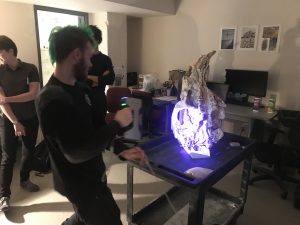
If you ask what’s the largest marsupial living today, the answer is the red kangaroo, which can be over six feet tall and 180 pounds. The extinct short-faced kangaroo was even larger, at 7-10 feet tall and over 500 pounds. But these ‘roos are dwarfed by the eponymous Diprotodonfrom the late Pleistocene, which could reach 10 feet in length, 6 feet at the shoulder, and weigh three tons (6000 pounds) – about the size of a hippo. UCMP has the largest complete skeleton of a Diprotodonin captivity, and it’s valuable for its completeness, because it can provide comparative data to help other museums assemble skeletons with accurate proportions.
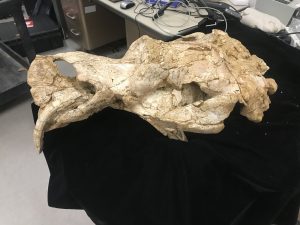
By the way, Diprotodongets its name from the two (di-) protruding (proto-) incisor teeth (-don) at the front of its skull, which were ever-growing – probably the closest thing to elephant tusks among the marsupials.
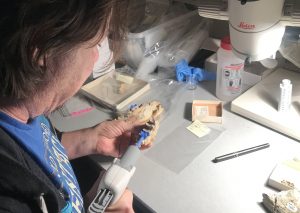
But what did all these various diprotodonts eat? That’s what Grant Gully is trying to find out. He does this by examining the surface wear on the teeth of the fossil marsupials and comparing it to the marks and scratches made by the diets of living herbivores. Koalas, for example, live in trees and feed on hard dry leaves (sclerophylls), whereas wombats favor grasses, which have inclusions of silica in their leaves that wear down the enamel and dentine of teeth. Horses have ever-growing, deep-rooted teeth that allow them to feed on these tough leaves, and wombats independently evolved a similar adaptation. Grant is studying several kinds of traces of mastication, including macrowear (features seen with the naked eye), mesowear (seasonal effects of dietary shifts), and microwear (tiny scratches that can be seen only with a microscope).
We’re delighted that 60 years after their collection these UCMP fossils from Australia are helping to inspire a whole new generation of research. We wish Isaac, Jacob and Grant the best success in their dissertation efforts, and we look forward to the finished products.